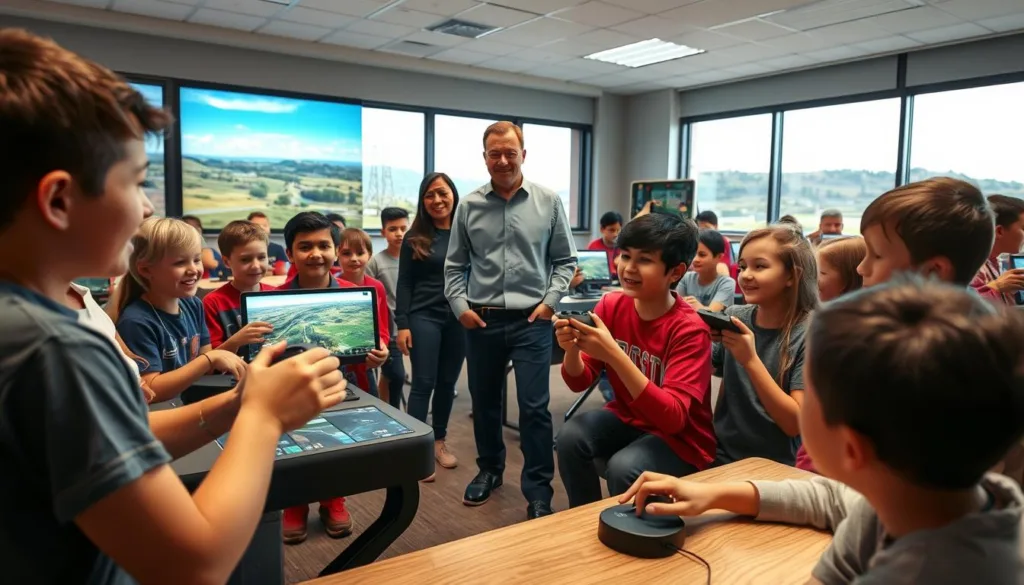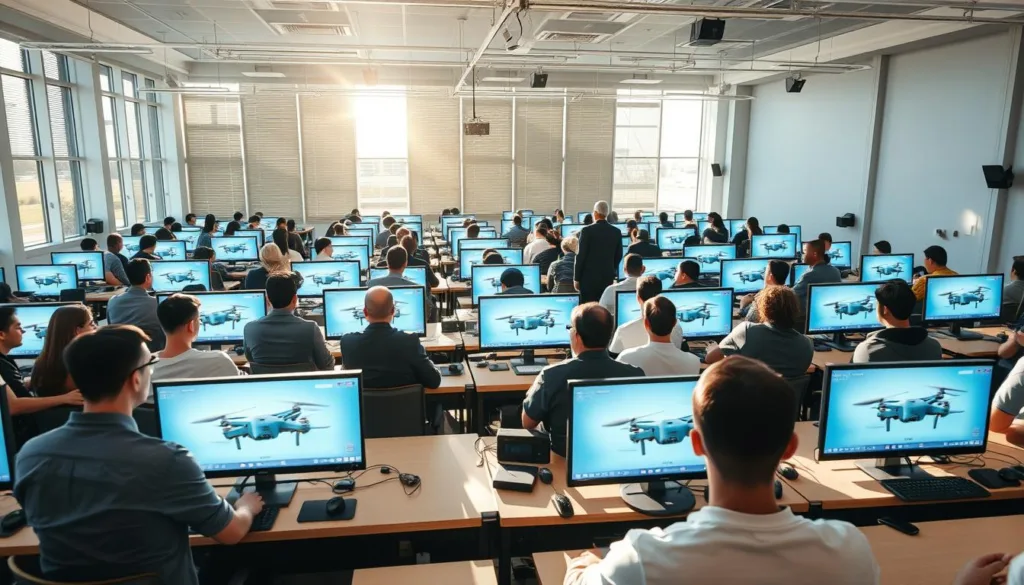As the demand for skilled drone operators continues to soar, educational institutions are adapting to meet the needs of various industries, including logistics, agriculture, and emergency response. Training drone pilots using realistic flight simulators in schools offers an innovative solution to this challenge. By incorporating drone flight simulation training into their curricula, schools can provide students with safe, cost-effective, and engaging ways to develop their skills. At SRIZFLY, we are dedicated to enriching the educational landscape and equipping the workforce of tomorrow with the knowledge and experience necessary for success in the rapidly evolving world of drone technology.
Key Takeaways
- Realistic flight simulators enhance learning and skill acquisition for drone pilots.
- Simulators offer a safe and controlled environment for training purposes.
- Drone pilot training is crucial for various industries like agriculture and logistics.
- Educators can easily integrate simulation training into existing curricula.
- SRIZFLY’s innovative technology supports effective learning outcomes.
- Students gain hands-on experience without the risks associated with real drone operations.
The Importance of Training Drone Pilots in Education
As technology evolves, the need for expertly trained drone pilots becomes increasingly crucial. Education institutions play a pivotal role in shaping the future of this industry. Ensuring students acquire essential skills for modern drone pilots lays the groundwork for their success in various professional environments.
Skills Required for Modern Drone Pilots
Modern drone pilots must possess a unique set of competencies to thrive. Key skills include:
- Spatial Awareness: Understanding aircraft positioning and movement in three-dimensional spaces.
- Problem-Solving: Addressing challenges swiftly during operations.
- Technical Proficiency: Familiarity with drone systems and software.
- Regulatory Knowledge: Awareness of regulations governing drone usage.
The Rise of Drone Technology in Various Fields
The application of drone technology is expanding rapidly across diverse industries. From mapping and agriculture to public safety, the demand for qualified pilots increases. Recent developments highlight the importance of drone pilot school programs that prepare students to meet these evolving needs.
Benefits of Early Exposure to Drone Operations
Engaging students early in drone operations fosters a robust understanding of the field. The benefits of early exposure to drone operations include:
- Enhanced Learning: Hands-on experience with drones accelerates learning.
- Career Preparedness: Early training equips students for future employment opportunities.
- Skill Development: Practical exposure helps cultivate essential skills.
How Realistic Flight Simulators Work
Flight simulator technology has progressed significantly, enabling immersive experiences for pilot training. These simulators utilize advanced graphics and real-time data processing to closely mimic actual flight conditions. Through this technology, students can learn vital piloting skills within a controlled environment, reducing risk and enhancing learning outcomes.
The Technology Behind Flight Simulators
At the core of flight simulators lies a blend of sophisticated software and hardware components. High-fidelity graphics create realistic environments, while motion systems offer tactile responses. The integration of flight physics ensures that every maneuver feels authentic. Real-time data processing provides feedback, allowing pilots to fine-tune their techniques continually.
Key Features of Advanced Simulators
The features of advanced simulators focus on a comprehensive learning experience. Some notable features include:
- Adaptive learning modes that adjust difficulty levels based on student proficiency.
- High-quality controller responses to simulate various flying techniques accurately.
- Accurate modeling of drone mechanics to ensure students understand operational nuances.
Customization Options for Schools
Customizable flight training elevates the educational experience. Schools can tailor lessons to meet diverse skill sets, focusing on various drone applications. This personalization aids teachers in addressing individual student needs, thereby enhancing engagement and understanding. With adjustable parameters, institutions can create a learning environment that fosters growth for every aspiring pilot.
Advantages of Using Simulators Over Real Drones
The modern landscape of drone training often highlights simulators as superior alternatives to traditional methods involving real drones. These advantages stem from various critical factors, such as cost, safety, and environmental impact.
Cost-Effectiveness of Simulator Training
Utilizing simulators presents a range of cost-effective training solutions. Schools can significantly lessen the financial burden related to purchasing and maintaining actual drones. Expenses tied to fuel, repairs, insurance, and operational risks diminish when adopting simulation technology. Given that simulators operate in a controlled environment, the overall training budget becomes more predictable and manageable.
Safety Concerns and Risk Mitigation
Another compelling reason for choosing simulators lies in enhancing safety in drone training. Traditional methods carry inherent risks associated with real aircraft operations. In contrast, simulators allow trainees to experience critical flight scenarios without physical danger. They provide opportunities to learn from mistakes without the risk of injuring themselves or others. This safety-first approach fosters a culture of risk awareness and responsibility among aspiring pilots.
Environmental Impact of Simulation Training
Finally, the environmental benefits of simulators play a crucial role in modern educational practices. Training with real drones typically requires extensive resources, contributing to a higher carbon footprint. Simulators, on the other hand, drastically reduce this impact. By employing advanced technology, educational institutions can actively engage in sustainable practices while still delivering effective training experiences.

SRIZFLY’s Advanced Flight Simulators
SRIZFLY flight simulators stand at the forefront of drone education technology, enhancing the training experience for students across various institutions. Our innovative approach focuses on providing a comprehensive learning platform that aligns with industry standards.
Overview of SRIZFLY Technology
The cutting-edge technology behind SRIZFLY flight simulators incorporates advanced graphics and realistic flight dynamics, ensuring an immersive learning environment for new pilots. These simulators allow students to practice in various simulated scenarios, providing a hands-on experience that closely mimics real-world flying conditions.
FAA-Aligned Training System Features
Our FAA-aligned training not only meets regulatory requirements but also emphasizes safety and efficiency. With a structured learning path, students progress through essential skills crucial for modern drone operations. This systematic training has shown to enhance retention and practical skills, leading to successful training programs in numerous educational settings.
Success Stories from Training Centers
Educational institutions incorporating SRIZFLY flight simulators have reported substantial improvements in training outcomes. Feedback highlights increased student engagement and higher success rates during assessments. These success stories serve as a testament to the effectiveness of our aviation training solutions.
Integrating Flight Simulators into Your Curriculum
Integrating flight simulators into school curricula represents a significant step towards modernizing drone education. The process entails several systematic steps crucial for effective implementation. Schools can ensure that simulator training aligns with academic standards while enhancing learning outcomes for students.
Steps for Implementation in Schools
To initiate the process of integrating flight simulators, schools must first assess their objectives and available resources. The following steps outline a practical approach to implementation:
- Conduct a needs assessment to identify gaps in the current curriculum.
- Choose the appropriate flight simulator technology that fits educational goals.
- Design a detailed plan that incorporates integrating flight simulators with theoretical lessons.
- Obtain necessary approvals and allocate budget for equipment and software.
- Implement a phased rollout with pilot programs to gather feedback.
Tailoring Lessons for Different Skill Levels
Tailored lessons for drone training are essential to cater to students with varying backgrounds and skill sets. Schools can use the simulator’s versatility to design lessons that accommodate beginners, intermediate, and advanced learners.
| Skill Level | Lesson Focus | Simulator Features |
|---|---|---|
| Beginner | Introduction to flight basics | Easy flight modes, guided tutorials |
| Intermediate | Advanced maneuvering techniques | Realistic environmental variations |
| Advanced | Complex missions and scenarios | Customizable scenarios for real-world applications |
Teacher Training and Support Resources
Teacher resources for drone education play a pivotal role in the successful integration of flight simulators. Comprehensive training programs should be made available to educators, enabling them to utilize simulators effectively. Professional development opportunities will enhance teachers’ confidence and improve the quality of instruction, thereby benefiting students immensely.
Enhancing Student Engagement Through Simulation
In today’s educational landscape, enhancing student engagement plays a vital role in ensuring effective learning. The utilization of flight simulators in drone training offers a dynamic platform for interactive learning experiences. These advanced tools captivate students, empowering them to actively participate in their education.
Interactive Learning Experiences
Interactive drone training elevates traditional learning by transforming it into a hands-on experience. Students have the opportunity to explore complex flight scenarios without the risks associated with real-world operations. This immersive approach not only maintains interest but also facilitates better understanding of drone technology and aerodynamics.
Building Confidence in New Pilots
Confidence is crucial for aspiring drone pilots. By simulating flight conditions, students can practice their piloting skills repeatedly and refine them in a safe environment. This continuous practice leads to a significant boost in self-assuredness when they transition into real-world flying. Engaging with realistic challenges reinforces their abilities, preparing them for actual piloting experiences.
Gamification Elements in Training
Incorporating gamification in education makes the learning process more enjoyable and competitive. Implementing elements like scoring systems, achievements, and challenges encourages students to strive for improvement. This not only sustains interest but also creates an environment where students feel motivated to learn. By leveraging gamification in education, programs can effectively increase student participation and excitement while mastering essential drone operations.

Customizable Simulation Scenarios
Customizable scenarios play a critical role in drone pilot training, allowing students to explore various applications across multiple disciplines. This approach enhances their understanding of real-world drone missions while fostering the development of vital skills needed in the field.
Real-World Mission Simulations
Engaging students with real-world mission simulations provides an immersive learning experience. For instance, they can participate in search and rescue operations or environmental monitoring tasks, which replicate real-life challenges. This hands-on practice prepares them to make informed decisions under pressure while increasing their operational preparedness.
Adapting Scenarios for Different Applications
Educators can tailor scenarios specifically to meet the demands of various sectors. Whether it is agriculture, logistics, or urban management, customizable simulations allow instructors to adjust settings and objectives. This adaptability ensures that training remains relevant, empowering students with specialized expertise.
Feedback Mechanisms for Continuous Improvement
Incorporating feedback in drone training is essential for fostering growth among pilots. Automated feedback systems provide insights on students’ performance, highlighting strengths and areas for development. This ongoing evaluation enables learners to reflect on their challenges and refine their skills effectively.
The Future of Drone Pilot Training
The landscape of drone pilot training is evolving rapidly. With advancements in technology, educational practices are adapting to incorporate the latest innovations, enabling more effective learning experiences. Future trends in drone education focus on automation, artificial intelligence, and immersive training methods, enhancing the way students engage with drone operations.
Trends in Drone Technology and Education
Emerging technologies are transforming the drone education field. Augmented reality and virtual simulations allow students to experience flight in a safe environment, amplifying their skills development. Educational institutions are leveraging these tools to create dynamic learning modules that reflect the real-world complexities of drone operations. The focus is on integrating cutting-edge techniques that prepare students for the competitive market ahead.
Preparing Students for Careers in Aviation
Institutions prioritize preparing students for aviation careers by aligning their curricula with industry demands. By emphasizing hands-on training with advanced simulators, students acquire both theoretical knowledge and practical skills. This comprehensive approach ensures they are equipped to handle various challenges in the aviation sector, instilling confidence as they embark on their professional paths.
The Role of Certification and Accreditation
Certification in drone training plays a critical role in establishing credibility for educational programs. Accreditation pathways enhance the legitimacy of training initiatives, ensuring they meet industry standards. Obtaining recognized certifications empowers students to stand out in the job market. This formal recognition of skills fosters trust in their capabilities, crucial for career advancement in aviation.
| Trend | Description | Implications for Education |
|---|---|---|
| AI Integration | Using artificial intelligence for personalized training. | Improves training efficiency and target-specific learning. |
| Augmented Reality | Enhancing real-world simulations through AR. | Boosts engagement and retention of complex concepts. |
| Certification Focus | Emphasis on industry-recognized credentials. | Increases employment readiness and marketability. |
Case Studies of Successful Implementation
Exploring the successful implementation of simulators in various educational institutions reveals significant advancements in drone training. These case studies highlight how schools that have integrated SRIZFLY flight simulators are enhancing their curricula and boosting student engagement while achieving measurable learning outcomes.
Schools Leading the Way with SRIZFLY
Several schools have adopted SRIZFLY flight simulators, crafting innovative approaches to drone education. Institutions such as Central High School and Brookstone Academy have led the charge, showcasing impressive results. The simulators enable students to practice complex maneuvers in a controlled environment, fostering skill development without the risks associated with real-life flying. This initiative demonstrates the successful implementation of simulators in their training programs.
Impact on Student Learning Outcomes
The impact on learning outcomes is apparent in improved academic performance and practical skills among students. Schools report enhanced critical thinking and problem-solving abilities, resulting from engaging simulation exercises. Increased retention of material leads to more competent pilot candidates, aligning educational objectives with industry demands. Clear improvements have been observed in flight assessments and students’ ability to handle real-world scenarios.
Testimonials from Educators and Students
Educators and students alike share positive experiences that emphasize the value of SRIZFLY simulators. Educators note that the technology has transformed their teaching methodologies, making lessons more interactive and impactful. Students express enthusiasm for the realistic training environment provided by the simulators. One student remarked,
“Training with SRIZFLY has truly prepared me for a future in aviation, making learning exciting and practical.”
These testimonials underscore the effectiveness of simulation technology in facilitating a vibrant educational atmosphere.
Getting Started with SRIZFLY’s Flight Simulators
As educational institutions explore innovative pathways to enhance their drone training programs, starting with SRIZFLY’s flight simulators is a strategic choice. To learn more about our offerings, educators and administrators can reach out to our dedicated team. We are available to provide comprehensive information tailored to your school’s unique needs, ensuring you have all the essential details before making a decision.
When considering pricing and licensing for flight simulators, SRIZFLY aims to offer competitive and flexible options suitable for different budget levels. Our packages are designed to accommodate various educational settings, allowing institutions to maximize the value of their investment in drone technology. We understand that each school has specific requirements, and we are here to customize solutions that fit seamlessly into your educational framework.
For those interested in trial setups for drone training, we provide a no-obligation 10-day free trial of our simulators. This opportunity allows schools to evaluate the effectiveness and suitability of our technology firsthand. Scheduling a demonstration or trial is straightforward, and our team is eager to assist you in taking the next steps towards transforming your drone pilot training program.
FAQ
What are the benefits of using flight simulators for drone pilot training?
Flight simulators provide a cost-effective and safe training environment, significantly reducing the risk of accidents and equipment damage. They allow students to practice diverse scenarios in a controlled setting while enhancing their operational skills and situational awareness, which are vital for becoming certified drone pilots.
How do realistic flight simulators improve training efficiency?
Our advanced simulators are designed to shorten training time by up to 50%, utilizing adaptive learning modes that cater to individual students’ needs. This allows learners to progress at their own pace while ensuring they master essential skills needed for drone operations in various fields like logistics, agriculture, and emergency response.
What skills do students gain from drone pilot training courses with simulators?
Students develop a range of skills, including spatial awareness, problem-solving, and a comprehensive understanding of drone systems and regulations. By engaging with realistic flight simulations, they also build their confidence and technical aptitude, preparing them for real-world drone operations.
Are SRIZFLY simulators aligned with FAA certification standards?
Yes, our flight simulators are designed to meet FAA guidelines, ensuring that training given through our platforms is compliant with industry standards. This alignment helps students not only gain the necessary skills but also positions them favorably for certification.
How can schools integrate simulator training into their curriculum?
Integrating simulator training involves strategic planning to align with academic standards. Schools can start by identifying curriculum objectives and then customizing simulators to match specific student skill levels. We provide resources and training for teachers to ensure effective implementation.
What types of scenarios can be created using SRIZFLY simulators?
SRIZFLY simulators offer customizable scenarios tailored to different drone applications, such as agricultural surveys, search and rescue operations, and aerial mapping. These real-world simulations enhance decision-making skills and operational readiness among aspiring drone pilots.
Can students receive feedback on their performance during simulation training?
Absolutely. Our simulators incorporate feedback mechanisms that allow students to analyze their performance continuously. This helps them identify areas for improvement and refine their skills, ensuring a thorough learning experience.
What is included in the 10-day free trial of SRIZFLY simulators?
The 10-day free trial includes comprehensive access to our flight simulation training features, allowing schools to thoroughly assess their capabilities without any financial commitment. It’s an excellent opportunity for institutions to evaluate how our technology can enhance their drone training programs before making a purchase.
Are there any success stories from institutions that have implemented SRIZFLY training?
Yes, many educational institutions have reported improved student engagement and enhanced learning outcomes after integrating SRIZFLY flight simulators. Testimonials from educators and students highlight the positive impact on skill acquisition and knowledge retention within their training programs.



